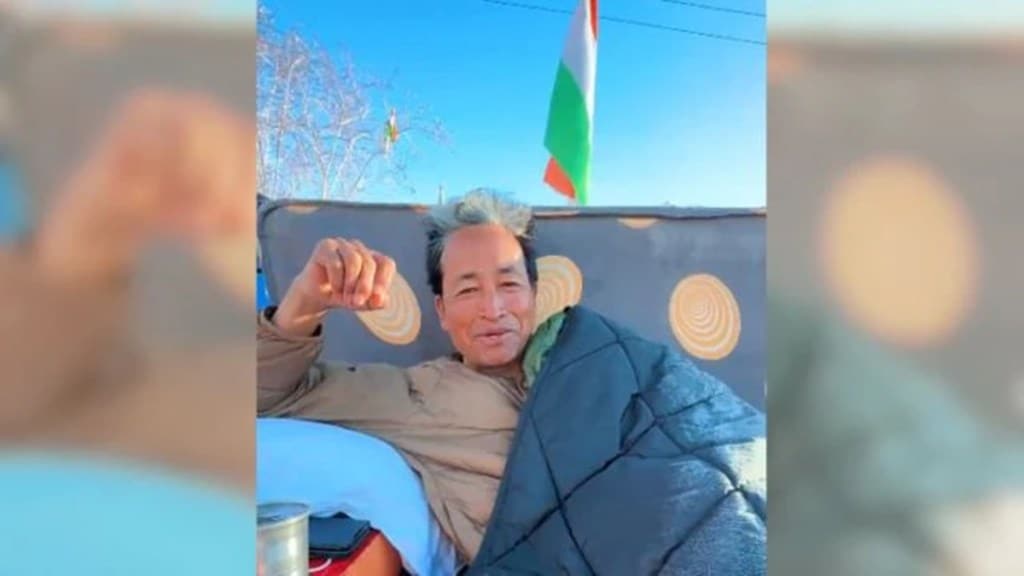A feeling of deception and anger are palpable on the chilly streets of Ladakh’s capital, Leh, where climate activist Sonam Wangchuk has been on a hunger strike for two weeks now.
As his ‘fast unto death’ protest entered its 14th day, Wangchuk continued to press for his demand for constitutional safeguards for the Union Territory of Ladakh and protection of ecologically fragile Ladakh’s ecosystem from industrial and mining lobbies.
Wangchuk is accompanied by scores of locals who want to remind “the Indian Government of their promises to safeguard Ladakh’s environment and its tribal indigenous culture”.
Also Read: EXPLAINED: Why the clamour for Sixth Schedule is growing in Ladakh
“250 people slept hungry in -12°C to remind the Indian Government of their promises to safegurad Ladakh’s environment and its tribal indigenous culture. This Government likes to call India the ‘Mother of Democracy’. But if India denies democratic rights to people of Ladakh, then it could only be called a Stepmother of Democracy,” Wangchuk, Ladakh-based engineer and educator, wrote in his post on X on Monday, while thanking those who participated in the previous day’s protest against Ladakh’s climate crisis.
In another post today, Sonam Wangchuk said that they are planning a border march to show the ground reality. He wrote on X, “250 people slept hungy in -12°C to safegurad Ladakh’s land, environment and tribal indigenous culture. Our nomads are losing prime pasture land to huge Indian industrial plants to the south & Chinese encroachment to the north. To show the ground reality we’re planning a Border March of 10,000 Ladakhi shepherds and farmers soon.”
Wangchuk’s protest had kicked off on March 6 from Leh, Ladakh, where he addressed a gathering of hundreds of people at 3,500 metres above sea level, announcing that his protest would take place in stages of 21 days each.
What are the Ladakhi peoples’ demands?
Following the repeal of Article 370 in August 2019, and the subsequent enactment of the Jammu and Kashmir Reorganisation Act, 2019, Ladakh was recognised as a separate Union Territory “without legislature”. UTs like New Delhi and Pondicherry have their own Legislative Assemblies.
Speaking from Leh earlier this month, he underlined two appeals in his address ahead of the protest: an appeal to all people to lead simpler lives, and a direct appeal to the government to fulfil its promise to include Ladakh in the Sixth Schedule of the Constitution and give statehood for the region, Indian Express reported.
“After many meetings, the government has backtracked on its promises and is talking of a much diluted version of what is already in the Constitution for this exact situation. So what happened and why did they change their mind?,” Wangchuk said, pointing out that the Bharatiya Janata Party-led Central government had mentioned the protection of Ladakh under the Sixth Schedule in their manifestos for 2019 Lok Sabha elections and 2020 Ladakh Hill Council polls.
Nearly five years ago, when Ladakh was declared a separate Union Territory, the people celebrated. But now, “People in Ladakh are disillusioned and feel they have been taken for a ride. I can only say that they (the BJP) only think about elections and how many seats they can get, but forget about people,” Wangchuk said.
Also Read: Centre mulling ‘Article 371-like’ support for Ladakh amid statehood demands
“People are asking whether declaring Ladakh a Union Territory was a ploy to sell off our mountains to industrial lobby and mining companies,” Wangchuk told NDTV.
The activist expressed environmental concerns surrounding the Himalayas and said industries have been exploiting the mountains by setting up dams and mining.
Wangchuk said his goal was to make the voices of Ladakhi people heard “so that the pressure of the industrial and mining lobbies is neutralised and the government can take a fair decision.”
He added, “The BJP had promised — not once but twice — that our demands will be met. It was one of their poll promises. They promised us that they would protect the identity of Ladakh under the sixth schedule. But sadly, promises have not been kept. Ladakh has no democratic representation.”
Wangchuk also claimed the morale of the soldiers was at its weakest. “The morale of Ladakhi soldiers is broken because Ladakh has neither democracy (Assembly) nor reservation (for locals),” he told NDTV.
People from at least 20 cities across India — including Mumbai, Pune and Hyderabad — have come out in support of Ladakh. Large-scale protests have been planned on March 20 and again on March 24.
Also Read: ‘Dead’ Article 370 is Finally ‘Buried’
What is the Sixth Schedule?
The Sixth Schedule under Article 244 of the Indian Constitution provides for the formation of autonomous administrative regions called Autonomous District Councils (ADCs).
ADCs are granted autonomy on legislative, judicial, and administrative matters within a state. They can have up to 30 members with a term of five years, and can make laws, rules and regulations with regard to land, forest, water, agriculture, village councils, health, sanitation, village- and town-level policing, etc.
Currently, it applies to the northeastern states of Assam, Meghalaya, Mizoram (three Councils each), and Tripura (one Council).
The protest comes after the Ladakhi leadership entered into talks with Centre to discuss threadbare the demands for Ladakh’s statehood, the inclusion of the Union Territory in the Sixth Schedule of the Constitution and the setting up of an exclusive public service commission for the high-altitude region. The talks, however, have remained inconclusive so far.

